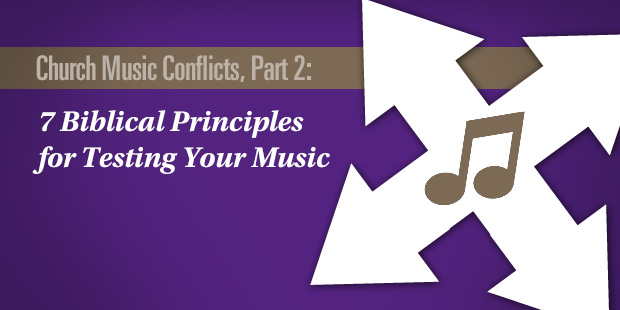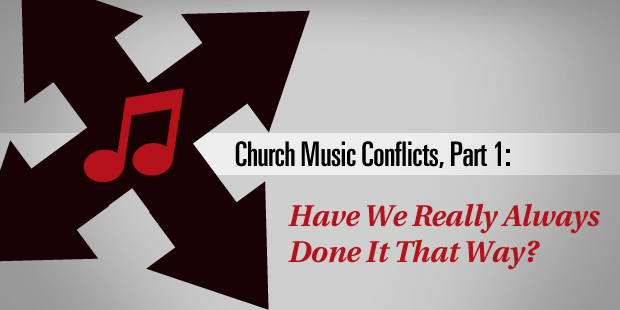
Church Music Conflicts, Part 2: 7 Biblical Principles for Testing Your Music
Oh so many moons ago, I wrote a book with Elmer Towns called Perimeters of Light. In that book, we talked about how to choose your music. In light of my comments yesterday about, “Church Music Conflicts,” I thought you might find this helpful.
The ideas are a bit of me and a bit of Dr. Towns. Here is the excerpt:
We must test everything by the Word of God. All of us are responsible to interpret the Bible and apply it to our life but this is where disagreement comes because we interpret differently. Music is a form that is used to convey meaning. It may be the most challenging of all forms because it involves preference, emotions, vocalization, etc.
The following seven test statements each relate to biblical principles that we should apply to our music to determine if it is Christian. Examine these seven test statements to determine if the music you prefer is Christian.
The first test is the message test. This test examines the words of the song to consider its message. Does this song express the Word of God? Does the message lift us, i.e., appeal to our higher nature, or do the words appeal to our lower nature? If we seek to glorify God, it is important that the message of the songs be consistent with the known and revealed will of God.
The second test to apply to our music is the purpose test. All music was written with a purpose in mind or heart. Determine whether the music is sad, joyful, uplifting or soothing. And again some music is designed to tempt you to sin, because it stirs your lust. Some “protest songs” of the “Hippies” were designed to get you to rebel against your government. Music that may be appropriate at one time, may not be appropriate at another time. When we apply the purpose test to our music, we choose songs that reflect our emotions or are likely to produce the emotion we wish to feel.
Third, we need to apply the association test. No music exists in a vacuum. The association test asks the question, “Does the song unnecessarily identify with things, actions, or people that are contrary to Christianity?” An otherwise good song may be rejected because of its associations with ungodly people, or worldliness, etc.
The churches that I (Ed) have pastored have generally used contemporary music. I remember coming into the worship team’s rehearsal. They were rehearsing “Amazing Grace.” This was not a song we sang frequently– and they were putting it to a new tune. That was the problem. Nothing was wrong with the song. However, the tune they chose was from another song: “The Rising Sun” or “There is a House in New Orleans.” Various artists have recorded it. If you know the tune, you will see that it fits nicely.
I explained to them that the association of the song would be unavoidable– the original song would impact the meaning today. The original song was from the drug culture.
I (Ed) was reminded of this when speaking to a group of pastors, some of whom were Jamaican. I was challenging them to consider that there is no such thing as Christian music, only Christian lyrics. I asked if God could use jazz; they said yes. I asked if God could use country/western, they said yes. I asked a few others; then I asked if God could use reggae. They were shocked and clearly expressed that it was not appropriate. Reggae music was about drugs and there would be no reason to sing about drugs in church. They had a point.
I then asked if it would be OK to use reggae music in my church where we have no concept of the drug connection. They agreed. The music was not the problem, the association was. The key question for the association test is this, “What does the music bring to mind in the heart of the worshipper?” Note, not what does it inspire in my heart– but what does it inspire in the heart of the worshipper.
For example, for me and for many others, rap music is about violence and misogyny (women hating). However, to some, it is about raging against something. Therefore, if the worshipper finds that the music helps him or her to rage against sin and the world, such a music can be associated with angst and struggle, but against something that matters. For example, one group sings:
Man is nothing, but you think that you’re bad
Fool if it wasn’t for my God, I would have already had you
Deny His name are you willing to admit it
And if so, are you willing to die for it
Cuz I am, He is my life and I don’t fear death
Cuz he already paid the Price.
What P.O.D. has done in their song “Preach” is to take a form and to use it for a different meaning. The form of rap is no less godly that the form of 4/4 time in most of our hymns. It is a canvas waiting for a picture. It does convey and associate–angst against something. P.O.D. has followed the pattern mentioned earlier.
The fourth test is the memory test. We tend to associate our memories and experiences with significant songs in our past. This can be positive or negative. The memory test asks, “Does the music bring back things in your past that you have left?” Remember, repentance is a significant step in conversion. If you have left the darkness, don’t sing those songs that make you want to return to the darkness. A song that may be enjoyed by some Christians should not be used by others who struggle with past memories.
This does not mean that we need to abuse the notion of “offending our brother.” It seems that many churches have adopted a “don’t-offend-anyone policy.” That is not what the scripture teaches. Scripture teaches that if what we do causes people to sin, we ought not to undertake a particular practice. Listening to contemporary music does not cause the senior adult to sin though it does offend–there is a distinct difference. The association test says, “Don’t use music that will lead people to sin.” It does not say, “Don’t use music that some will find distasteful.”
The next test is the emotions test. Music stirs our emotions. Both negative and positive emotions can be stirred by music. The emotions test asks, “Does the music stir our negative or lustful feelings?” Christian music should stir our passion for godliness, prayer and righteous living. If music stirs your lust and makes you idolize or crave sin, it is wrong; no matter how innocent it may appear. This test causes us to evaluate how music affects us emotionally.
The understanding test seeks to determine the meaning of the song. Should we use music that we don’t understand or have a difficult time finding the melody? Some people enjoy and understand classical music. Other people can’t tolerate it or hate it. Others enjoy and understand country/western. Again, other people can’t tolerate it or hate it. Applying the understanding test, those who appreciate classical music would find it easier to worship God listening to a recording of Handel’s Messiah than a southern gospel quartet.
The final test may be described as the music test. This, like many of the others, is a “cultural” test that will differ from place to place. It asks, is there a “song within the song?” The music test looks at the song to determine its merits based on hymnology. It seeks to determine if the song is singable, if it flows comfortable from one line to another. Does it make your heart join in the song? A song may have Christian words and is sung by a dedicated follower of Jesus Christ, but the music is flat and leaves the audience empty. That particular song will probably pass out of existence because it fails the music test.
The history of church music suggests that every generation has its own music. Today, many older Christians reject the contemporary music of the younger believers, while the younger don’t understand or use the music of past generations.
These tests lead us to one simple conclusion: God can use ANY form of music. God has no musical style or preference. Therefore, with the exception of the message and purpose test, the only tests that we have provided are cultural. The question is asked, “What impact does this music have on the culture via association, memory, emotions, understanding, and music?” These are not easy questions–but they are essential.
When a worship team is choosing music, it needs to think through some important issues. They may have the freedom to choose, but discernment calls them to choose wisely.
Read more from Ed here.

Tags: Church Music, Ed Stetzer, Worship














